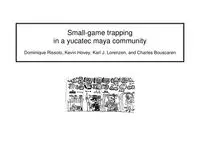
Small Game Trapping 2004 PDF
Preview Small Game Trapping 2004
Small-game trapping in a yucatec maya community Dominique Rissolo, Kevin Hovey, Karl J. Lorenzen, and Charles Bouscaren The Socio-Cultural Significance of Small-Game Trapping Among the Modern Maya Trapping small-game, particularly pocket gophers (Orthogeomys hispidus; ‘ba’ in Maya) is an activity reserved almost exclusively for young boys. These boys are typically not old enough to assist their fathers in the milpa and are therefore encouraged by their parents to make themselves useful through a number of activities including the trapping of small game. We have identified at least three major socio-cultural functions of small-game trapping: 1) Through the search for suitable trapping locations, the boys learn how to navigate in the forest. Such navigation skills are crucial since men are routinely required to venture into the forest to hunt, collect building materials, and establish new milpas. 2) As the boys select natural materials for trap construction, they learn to identify numerous plants as well as acquire a detailed knowledge of the physical properties of plants and their seasonal cycles. 3) The boys form social bonds through teamwork. Such relationships continue into adulthood and play an important social, political, economic role in daily community life. Trapping, therefore, functions as a process by which Maya boys unwittingly acquire invaluable skills, which will eventually be expected of them as men. The complex and far-reaching function of small-game trapping in Maya society thereby mitigates the relatively small amount of meat produced by such a time- consuming and labor intensive process. GOPHER SNARE TRAP ANATOMY OF A GOPHER SNARE TRAP (A) Spring sapling. (B) Bark strip attached to the wire snare. (C) Two parallel shafts, which are embedded into the sidewall of the trap. These shafts flank the snare. When the trap is tripped, the gopher is pulled up by the snare and pinned against the shafts. (D) Large stone used to both anchor the parallel shafts and the distal end of the shaft that anchors the bait vine to the floor of the gopher burrow. (E) The shaft that anchors the bait vine to the floor of the gopher burrow. (F) The bait vine attached to the spring sapling. (G) The bark strip attached to the spring sapling. (H) The roof supports. This is a view of the trap before the covering of leaves and soil is applied. From this perspective, the gopher will approach the trap from the upper right-hand corner of the illustration. PLANTS USED IN GOPHER TRAPPING AND PREPARATION TRAP COMPONENT SCIENTIFIC NAME MAYA NAME Spring, Bark Strip, and Shafts Xylosma anisophyllum (Stanley) puuts’ mukuy Bait Vines Turbina corymbosa (L.) Raf. x-tabentun Cydista aff. potosina [K.Schum & Loes] ek’kix Trap Roof Supports Cecropia pelata L. k’o’och Trap Roof Cover Guettarda combsii Urban taas ta’abil Pit Oven Cover Guazuma aff. ulmifolia Lam. piixoy CONSTRUCTING A GOPHER SNARE TRAP The trappers attach the bait vine The trap roof is to the spring sapling. then covered with taas ta’abil leaves and soil. GOPHER REMOVED FROM SNARE TRAP PREPARING A GOPHER IN A PIIB (PIT OVEN) The fur is burned-off as the fire is reduced to coals The piib is covered with piixoy leaves and soil. After the gopher has been cooked underground for about twenty minutes, it is removed and consumed whole “HEN-COOP” TRAP Used for trapping small birds, they are typically referred to as tsutsuy (dove) traps. The trap is set: note trip-line and trigger. BASKET TRAP Like the hen-coop trap, it is used to trap small birds and is set in essentially the same fashion
